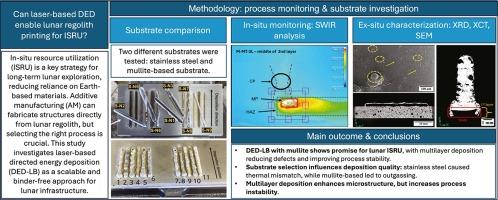Laser-based directed energy deposition with mullite: A necessary step for lunar regolith printing
IF 7.9
2区 材料科学
Q1 MATERIALS SCIENCE, MULTIDISCIPLINARY
引用次数: 0
Abstract
Additive manufacturing (AM) is pivotal in advancing in-situ resource utilization (ISRU) technologies for space exploration, enabling the construction of lunar infrastructure directly from local materials such as lunar regolith. Among the various AM techniques, laser-based directed energy deposition (DED-LB) offers scalability and binder-free processing, making it highly suitable for fabricating large-scale components on the Moon. However, the limited availability of actual lunar regolith necessitates the use of simulants. Mullite, an aluminosilicate ceramic with a chemical composition closely resembling that of highland lunar regolith, is a promising candidate. In this study, synthetic mullite with a spherical morphology was employed as a model feedstock to investigate the feasibility of fabricating multilayer 3D printed components using the DED-LB process. The high thermal stability and round particle morphology of mullite make it an ideal proof-of-concept material to understand the thermal and mechanical challenges associated with lunar regolith printing. A combination of in-situ thermal monitoring and microstructural characterization was used to define optimal process parameters and assess print quality. The results demonstrate the suitability of mullite for DED-LB and contribute to the development of scalable AM processes for future lunar infrastructure.

莫来石激光定向能沉积:月球风化层印刷的必要步骤
增材制造(AM)对于推进空间探索的原位资源利用(ISRU)技术至关重要,可以直接使用月球风化层等当地材料建造月球基础设施。在各种增材制造技术中,基于激光的定向能沉积(ed - lb)提供了可扩展性和无粘合剂的加工,使其非常适合在月球上制造大型部件。然而,由于实际的月球风化层有限,因此必须使用模拟物。莫来石是一种铝硅酸盐陶瓷,其化学成分与高地月球风化层非常相似,是一种很有希望的候选者。在本研究中,采用球形形态的合成莫来石作为模型原料,研究了使用d - lb工艺制造多层3D打印部件的可行性。莫来石的高热稳定性和圆形颗粒形态使其成为理解与月球风化层打印相关的热学和机械挑战的理想概念验证材料。结合原位热监测和微观结构表征来确定最佳工艺参数并评估打印质量。研究结果证明了莫来石对d - lb的适用性,并有助于为未来月球基础设施开发可扩展的增材制造工艺。
本文章由计算机程序翻译,如有差异,请以英文原文为准。
求助全文
约1分钟内获得全文
求助全文
来源期刊

Materials & Design
Engineering-Mechanical Engineering
CiteScore
14.30
自引率
7.10%
发文量
1028
审稿时长
85 days
期刊介绍:
Materials and Design is a multi-disciplinary journal that publishes original research reports, review articles, and express communications. The journal focuses on studying the structure and properties of inorganic and organic materials, advancements in synthesis, processing, characterization, and testing, the design of materials and engineering systems, and their applications in technology. It aims to bring together various aspects of materials science, engineering, physics, and chemistry.
The journal explores themes ranging from materials to design and aims to reveal the connections between natural and artificial materials, as well as experiment and modeling. Manuscripts submitted to Materials and Design should contain elements of discovery and surprise, as they often contribute new insights into the architecture and function of matter.
 求助内容:
求助内容: 应助结果提醒方式:
应助结果提醒方式:


